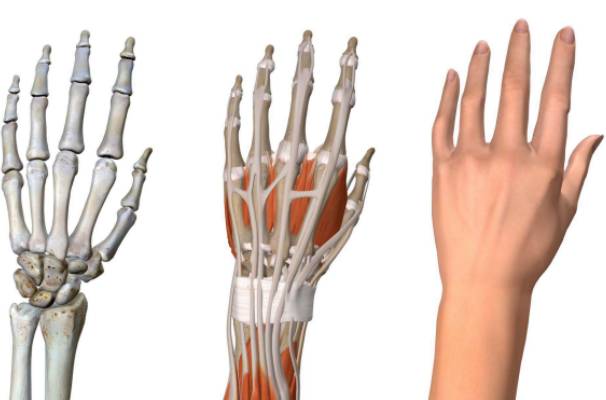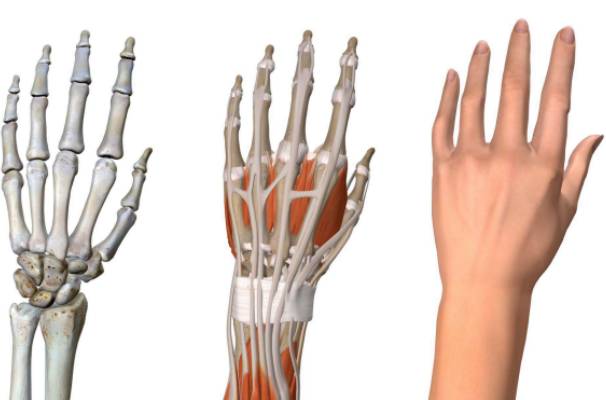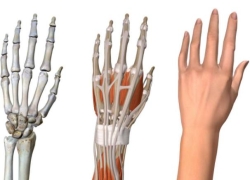
Our hands distinguish us significantly from all other species, enabling us to execute a vast range of intricate tasks. We use our hands countless times throughout the day, often without even realizing it. From basic activities like eating, dressing, and grooming to more complex tasks such as typing, writing, or crafting, our hands are in constant use. The frequency varies greatly from person to person based on their occupation, daily routines, and activities. Some estimates suggest that an average person might make thousands of hand movements daily.
Let’s break down the anatomy of your most precious tool - your hands.
Skeleton
Let’s start with discussing the deepest structures of your hands, the bones. Your hand is composed of 27 bones, which can all be categorized based on location and function. First, the 8 carpal bones make up your wrist, forming the foundation of your hand. Next, there are the 5 metacarpals which are the bones that make up the palm of your hand, providing structural support. Finally, there are 14 phalanges, the bones that make up your digits. Every finger has one proximal, one intermediate, and one distal phalanges, apart from the thumb which only has one proximal and one distal phalanges.
Joints
All of the bones of the hand are connected via joints, allowing for movement of these bones. There are four types of joints in the hand including intercarpal, carpometacarpal, metacarpophalangeal, and interphalangeal joints. Intercarpal joints simply hold the carpal bones together, allowing for little to no movement. Carpometacarpal joints are between the carpal and metacarpal bones, predominantly used in the rotation of the thumb. Metacarpophalangeal joints are between the metacarpal and proximal phalangeal bones, allowing hinging at the base of our fingers. Finally, interphalangeal joints are between proximal, intermediate, and distal phalangeal bones. Each finger has two interphalangeal joints, apart from the thumb only having one, which allows for hinging within our digits.
Connective Tissue
Various ligaments and tendons make up the connective tissue of our hands. Ligaments connect bone to bone, providing stability within the hand. Ligaments help your joints move smoothly, prevent overextension, and enable precise movements. Tendons connect muscle to bone, enabling the muscle to exert force on the bone, moving it in a particular direction. Tendons enable our hands to manipulate and grip objects.
Muscles

The muscles of our hand and wrist are responsible for any movement. There are two types of muscles found in the hand, the intrinsic and extrinsic muscles. Intrinsic muscles are found within the hand itself, balancing our fingers and controlling fine movements such as writing and picking up small objects. Extrinsic muscles originate in the forearm but act on the hand controlling larger movements such as gripping, lifting, and rotating the hand.
Nerves
There are many nerves throughout our hands and wrists that detect sensations and signal our muscles to move. There are three main nerves in our hand and wrist including the median nerve, ulnar nerve, and radial nerve. The median nerve runs through the carpal tunnel of the wrist, providing sensation to the thumb, index, middle, and half of the ring finger. The ulnar nerve provides sensation to the pinky and the other half of the ring finger. Similar to the median nerve, the radial nerve also provides sensation to the thumb, index, middle, and half of the ring finger, but only on the top of the hand.
Your hands are a vital instrument for everyday tasks. Hands perform functions like touching, grasping, feeling, holding, manipulating, and are an important part of who we are and how we see ourselves. The bones, joints, connective tissue, muscles, and nerves all work cohesively every second of every day to make the hand your body’s most precious tool.
When you experience pain or injury to your hands, it can be a major setback in life, losing the ability to perform basic tasks. Dr. Jason Shrouder-Henry specializes in the treatment of the hand, with advanced treatment options for children, teens and adults.
AUTHOR: Jason Shrouder-Henry MD, MBA is a Board Certified and fellowship-trained orthopedic surgeon specializing in the hand, wrist, elbow and shoulder throughout Chicagoland.


